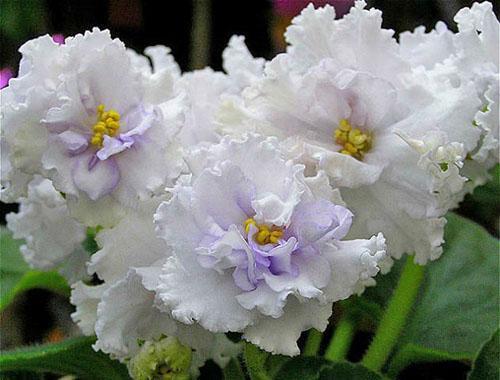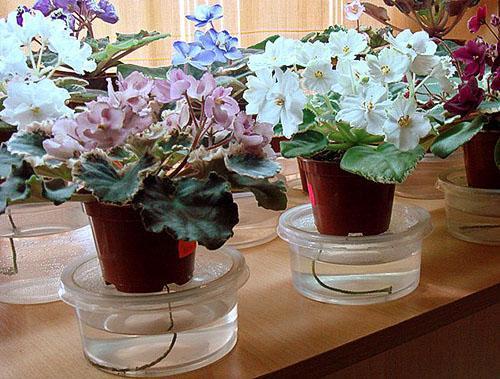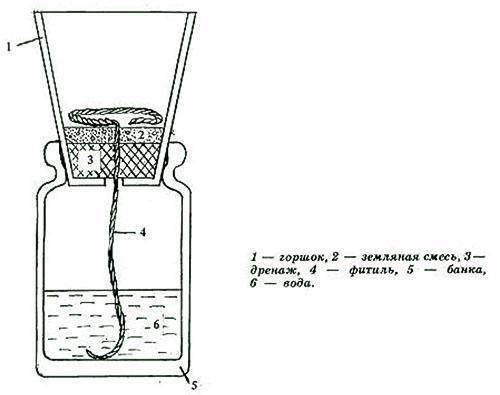Reproduction and care of room violets
 Violets have long been considered an indicator of well-being in the room where they settled. If the owners are attentive and take care of all the inhabitants of the dwelling, then Saintpaulia will receive its share of attention and will delight with its abundant flowering. Reproduction and caring for a room violet will not present difficulties if you know the plant's agricultural technology.
Violets have long been considered an indicator of well-being in the room where they settled. If the owners are attentive and take care of all the inhabitants of the dwelling, then Saintpaulia will receive its share of attention and will delight with its abundant flowering. Reproduction and caring for a room violet will not present difficulties if you know the plant's agricultural technology.
On this topic:violet - how to care to bloom?
Conditions and microclimate favorable for the plant

- location;
- duration and lighting intensity;
- temperature regime and air humidity;
- watering mode;
- timely transplantation and reproduction of violets.
Place a room violet in a well-lit place on all windows, except for the northern ones, without direct sunlight. Lack of lighting will provoke disease, flowering will stop. Violets can be grown on racks in the depths of the apartment, if you create them with artificial lighting of the daytime spectrum, for at least 10 hours.
The temperature in summer can be 21-25 degrees, in winter 15-18 is enough. Seedlings take root or rooting is carried out at 25 0... All processes slow down at a temperature close to 30 0... Air humidity should be around 50%.
 Violet does not like excessive moisture. How often to water violets? During flowering, bottom or traditional watering should be daily, in winter twice a week. The main thing is not to overflow and to avoid stagnant water in the sump. Excessive watering causes no air to the roots and can rot. In modern care, wick watering of violets and other indoor plants has aroused great interest.
Violet does not like excessive moisture. How often to water violets? During flowering, bottom or traditional watering should be daily, in winter twice a week. The main thing is not to overflow and to avoid stagnant water in the sump. Excessive watering causes no air to the roots and can rot. In modern care, wick watering of violets and other indoor plants has aroused great interest.
 Saintpaulia grows on lean ground with little additional nutrition. Therefore, the substrate is often replaced for full content. With annual replanting, only the substrate is replaced, without increasing the volume of the pots. A transplant is required every three years. The systematic cultivation of new specimens allows you to remove old plants that are losing their decorative effect. It is easy to propagate a violet, as well as to transplant, knowing the basic rules.
Saintpaulia grows on lean ground with little additional nutrition. Therefore, the substrate is often replaced for full content. With annual replanting, only the substrate is replaced, without increasing the volume of the pots. A transplant is required every three years. The systematic cultivation of new specimens allows you to remove old plants that are losing their decorative effect. It is easy to propagate a violet, as well as to transplant, knowing the basic rules.
Transplanting and reproduction of indoor violets
 Reproduction of plants can be carried out using leaves, shoots from the root of 3 - 4 leaves, seeds. Most often, the method of leaf grafting is used, we will analyze it in more detail.
Reproduction of plants can be carried out using leaves, shoots from the root of 3 - 4 leaves, seeds. Most often, the method of leaf grafting is used, we will analyze it in more detail.
For reproduction, a leaf is taken from a healthy plant. If this is a large rosette, then the leaves of the second tier are selected, rooted through a glass of water. In young plants or young leaves of the upper tiers take root directly in the substrate, in wet moss, in a mini-greenhouse.
 The leaf should have a tug, before laying for germination, a fresh cut is made, which is renewed if the stalk is rotted instead of callus. Some varieties of Saintpaulias do not root through water, only in moss or substrate.
The leaf should have a tug, before laying for germination, a fresh cut is made, which is renewed if the stalk is rotted instead of callus. Some varieties of Saintpaulias do not root through water, only in moss or substrate.
Substrate requirements
 The violet soil should be light and slightly sour. The compositions are different, the main thing is that it must be breathable and nutritious. Constant moderate hydration allows minerals to dissolve, releasing salts for nutrition. One of the formulations recommended for Saintpaulias:
The violet soil should be light and slightly sour. The compositions are different, the main thing is that it must be breathable and nutritious. Constant moderate hydration allows minerals to dissolve, releasing salts for nutrition. One of the formulations recommended for Saintpaulias:
- garden land - 5 parts;
- peat - 3 parts;
- sand - 1 part.
You can take ready-made soil for seedlings "Vermion". But any of the compositions should first be treated against pathogens and pests, then add to 2 liters of the finished mixture:
- "Living Earth" 1 liter;
- vermiculite 1 cup;
- perlite 1 glass;
- sphagnum moss 1.5 cups;
- crushed charcoal 2/5 cup;
- superphosphate powder on the tip of a knife.
Expanded clay is required for drainage.
Violet dishes
 Containers should be wide. At a height of 10 cm for an adult plant, a cup 15-20 cm in diameter is suitable. The correct ratio is important, so a larger drainage layer is laid out in a deep narrow pot. Spacious dishes will delay flowering until they are filled with roots. When transplanting, the roots should be initially cramped. Any dish is used, but plastic is better, since earthenware has pores, and a clod of earth dries quickly.
Containers should be wide. At a height of 10 cm for an adult plant, a cup 15-20 cm in diameter is suitable. The correct ratio is important, so a larger drainage layer is laid out in a deep narrow pot. Spacious dishes will delay flowering until they are filled with roots. When transplanting, the roots should be initially cramped. Any dish is used, but plastic is better, since earthenware has pores, and a clod of earth dries quickly.
Irrigation water
 Soft moist settled water is used. If watering is bottom, then after the soil layer gets wet, it is required to remove the remaining water from the sump immediately after watering. Modern wick irrigation of violets allows you to create uniform moisture and reduces the care time.
Soft moist settled water is used. If watering is bottom, then after the soil layer gets wet, it is required to remove the remaining water from the sump immediately after watering. Modern wick irrigation of violets allows you to create uniform moisture and reduces the care time.
When planting violets with roots, the following conditions should be observed:
- Create a drainage layer, having previously protected the drainage holes from clogging, by pulling a wick through them, and laying it in a layer of poured earth. Place the roots so that the neck of the plant is in the middle of the cup, below the rim for watering. Gently sprinkle the roots with earth, shaking slightly and mechanically compacting the substrate.
- After sprinkling to the neck of the roots, water the soil so that it lies against the roots. After the clod has settled, pour the dry mixture on top and mulch with vermiculite from evaporation.
- Cover the new plant from above from evaporation, ventilate. but do not water until it takes root.
 The emergence of new leaves on the bush, the appearance of young seedlings on the cuttings will serve as a sign of survival.
The emergence of new leaves on the bush, the appearance of young seedlings on the cuttings will serve as a sign of survival.
It is not necessary to use a larger pot for every transplant. It depends on the condition of the root system. If she has tightly entangled a lump of earth and retains its shape when removed from the pot, you need a 1-1.5 cm large dish.
 The question is often asked whether it is possible to transplant a blooming violet. This is undesirable, if the plant blooms, then it still has enough nutrition, wait until the end of flowering. But if the plant is flooded, the transplant is inevitable. In this case, you should revise the roots and remove the brown ones. You can thin out up to 2/3 of the root system and remove part of the leaves, use them for reproduction. For flowering to recover faster, you need to take smaller transplant dishes.
The question is often asked whether it is possible to transplant a blooming violet. This is undesirable, if the plant blooms, then it still has enough nutrition, wait until the end of flowering. But if the plant is flooded, the transplant is inevitable. In this case, you should revise the roots and remove the brown ones. You can thin out up to 2/3 of the root system and remove part of the leaves, use them for reproduction. For flowering to recover faster, you need to take smaller transplant dishes.
 How to plant a violet if it does not bloom and has lost its decorative appearance due to old age? In such a plant, the stem is bare from below. Cut off the top with a sharp knife, root in water and then plant like all other violets.
How to plant a violet if it does not bloom and has lost its decorative appearance due to old age? In such a plant, the stem is bare from below. Cut off the top with a sharp knife, root in water and then plant like all other violets.
If the violet, which blooms beautifully, has fallen off the lower leaves and the trunk is bare, it can be deepened, but not immediately. First, you need roots to appear on this part of the plant. Wrap the stem in sphagnum moss, which has bactericidal and moisture-retaining properties. When roots appear on it, you can add earth.